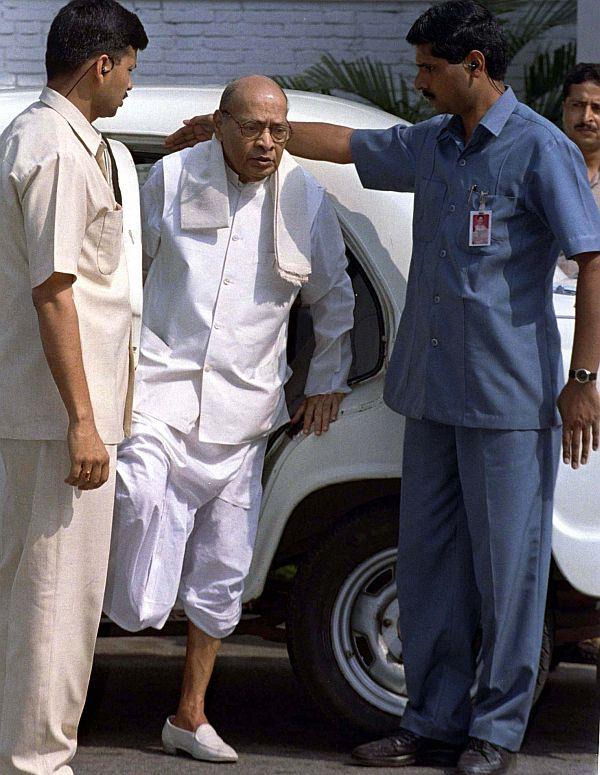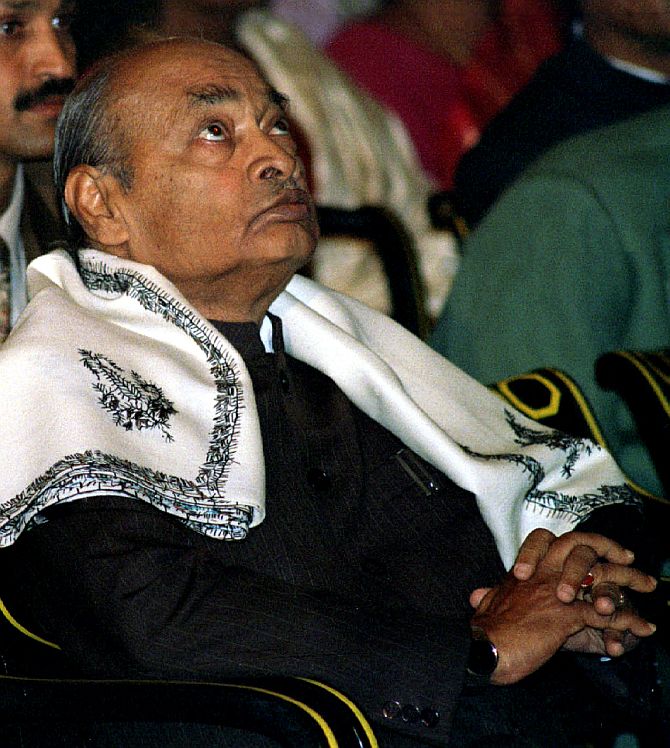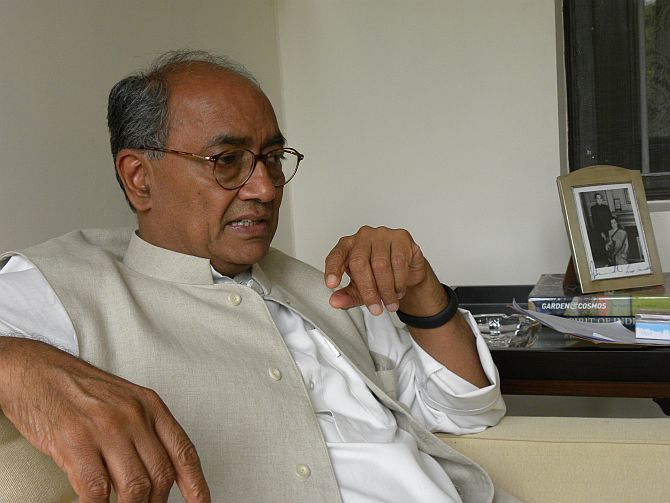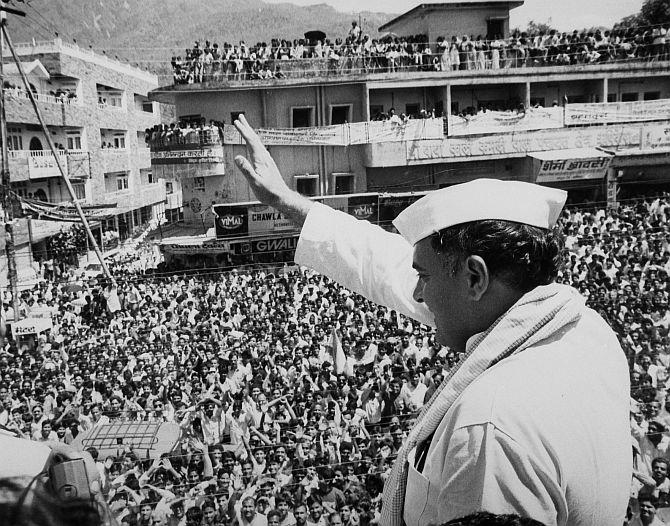 | « Back to article | Print this article |
'There are indications in Rao's book of his desire to build a Ram temple'
Ram Bahadur Rai, editor of the Hindi magazine Yathawat, has followed Indian politics for nearly 50 years with passion. The senior commentator knows the Ram temple-Babri masjid movement inside out, having been close to many Rashtriya Swayamsevak Sangh ideologues and, later, worked closely with former Prime Minister Chandra Shekhar. Recently he has made some sensational revelations from times past in his magazine on the Ayodhya issue.
In a conversation with Gopal Krishna, in the context of these disclosures, he shares how then prime minister P V Narasimha Rao had a plan to construct a Ram temple in Ayodhya. He also speaks about the politics of Congress leader Digvijaya Singh who had then extended a helping hand to Rao in the latter's efforts to help build a temple there. This is the first of a two-part interview with Rai.
What is the basis of your claims in your magazine that Prime Minister Rao wanted to construct a Ram temple at Ayodhya?
There are two foundations for the claims made in the story. One is Rao’s book which was published after his death. The background to the events of December 6, 1992 (when the Babri masjid was brought down), what happened after that day, and the events of that day find mention in it. There are indications of his desire in that book.
The other book, Wheels Behind the Veil - PMs, CMs and Beyond, by P V R K Prasad, former media advisor and additional secretary to Rao, in which he has said that whatever he has written is not hearsay.
I have written only those things on which I myself was working on or in which I had some role to play.
Click on NEXT to read further...
'Indira Gandhi took a pro-Hindu line'
To contextualise what Rao proposed to do in Ayodhya, it is important to understand what kind of relationship various prime ministers had with the Ayodhya issue and their interventions in the matter from 1947 till 1984. Can you eleborate on this?
On the night of December 22-23, 1949, an idol of Ram Lalla was kept inside the ‘Babri masjid’ religious structure of which the people of the temple movement say it appeared on its own. From that day on, the idol was kept there till 1986, and that is one part of the phase. After the idol was kept there, Govind Ballabh Pant, then Uttar Pradesh chief minister, and Sardar Vallabhbhai Patel, the then deputy prime minister and home minister, decided not to remove the temple and idol.
Uttar Pradesh chief secretary Bhagwan Sahay wanted the idol to be removed to maintain the status quo. K K Nayar, the district commissioner (magistrate), said he can do it but his advice was that this should not be done because he did not have sufficient forces to ensure peace in Ayodhya and the adjoining areas. Ultimately, Sahay allowed, in writing, the idol inside the site. This is evident from available correspondence.
The matter went to the court and even the court allowed the idol to remain there. It made arrangements for proper worship but the front gate was locked by the administration. The idol was inside. Pandits go there thrice to perform puja. Pandits are paid for it. But the front gate of the temple remained locked.
In 1986, one person went to the Faizabad court and asked why although worship has been going on since 1949, the front gate remained locked. The magistrate noted that worship was going on and asked that the lock be opened.
The incident of opening the temple's lock is related to Indira Gandhi and Rajiv Gandhi. After the mass conversions in Meenakshipuram, in Tirunelveli district, Tamil Nadu, in 1981 (where Mallar families en masse converted to Islam, apparently to express political dissent) and the failure of her experiment in Jammu and Kashmir in 1983 (post an accord between Sheikh Abdullah and Indira Gandhi in 1974, the former defeated her in the elections of 1977 and Farooq Abdullah defeated her in March 1983), Indira Gandhi took a political line two years prior to elections. It was a Hindu line.
The upsurge due to the Meenakshipuram incident led to the formation of an organisation called the Virat Hindu Samaj. Dr Karan Singh became its president with the permission of Indira Gandhi. Giridhari Lal Goswami, the father of Ramakant Goswami, minister in the current Sheila Dikshit government, was very active in this Samaj. All shankaracharyas, maths, sects and the Vishwa Hindu Parishad were part of it.
In Uttar Pradesh, Dau Dayal Khanna, a former state Congress minister known to be very close to Indira Gandhi, was the first one to raise the Ayodhya issue in 1983. Around February 1983, a meeting of the Virat Hindu Samaj was organised in Muzaffarnagar. Gulzarilal Nanda, former acting prime minister, presided over the meeting. A senior functionary of the Rashtriya Swayamsevak Sangh, Rajju Bhaiya (Professor Rajendra Singh), was present at the meeting. I was also present. I had come to Delhi in October-November 1982. At the behest of Dr Karan Singh, Dau Dayal Khanna raised the Ayodhya issue.
In 1984, one can understand the VHP’s strength from the a camp it organised in Faizabad on a 50-acre plot of land after cutting down crops with the order of the district collector. Then Congress chief minister Vir Bahadur Singh had instructions from above to facilitate it. It was a camp meant for 5,000 people but only 540 people turned up. The DIG of that time said that very few people have turned up. Other people who turned up later were the people of Chief Minister Vir Bahadur Singh.
Arun Nehru, a Congress minister, knew the Indira Gandhi’s line on the issue. It was at the behest of Nehru that Vir Bahadur Singh asked for the opening of the temple's lock. Later, the VHP made it its own issue in 1984.
Click on NEXT to read further...
'Rao acted in furtherance of what was done by Indira and Rajiv'
What is startling about the disclosure you have made in your cover story?
The conversation which Narasimha Rao had with his media advisor Prasad was unknown until now. There was an impression going around but a recorded conversation was not there. It is not hearsay. It is factual. Everything is factual. I was myself a participant. The story starts thus: Narasimha Rao called Prasad after December 6, 1992, and told him, ‘Woh samajhte hain ki Bhagwan Ram kewal unhi ke hai toh kya Bhagwan Ram unhi ke hain?” (They think that Lord Ram only belongs to them. Does Lord Ram belong to them only?).
There is another thing which I have not said in the story. Rao’s decision to get a temple constructed had its reasons. One was in furtherance of what was being done by Indira Gandhi and Rajiv Gandhi. He has written in his book all that had happened, but only those aspects which could be written. He indicates how Sardar Patel and Pant had allowed the idol to be kept there.
Besides the facts in the books, what is being disclosed in the story is that senior journalists Nikhil Chakravartty, Prabhash Joshi and R K Mishra went to meet Narasimha Rao and asked why he allowed the Babri masjid to be demolished.
What Rao told them was: "Aap logon ko kya lagta hai ki mujhe rajniti nahi aati? (Do you think I do not know politics?). I want to take away the issue from them (the RSS)."
I was also called by these three journalists whenever their vehicle used to get stuck. I used take appointments with PM Rao for them and sometimes accompanied them.
You were familiar with Chakravartty, Joshi and Mishra and also with their views regarding the Ayodhya issue. In the light of that do you see a corroboration of facts or contradiction between what they have said and what Rao’s media advisor has written in his book?
There is no contradiction. Both were operating at two different levels of dialogue. This has to be kept in mind. What these three veteran journalists were doing was at a different level and Prasad’s level was different. What was common between the two levels was the Ayodhya dispute. These journalists were trying to ensure that prior to December 6, 1992, there could be a compromise between the government and the VHP and RSS.
What these three journalists were doing prior to December 6, 1992, was of their own initiative and not at the instance of Rao. I knew Joshi. It was his initiative to look for some amicable solution. Chakravartty and Joshi were quite independent people and they were involved because they felt that it was their duty. It is possible that Mishra may have been part of the team at Rao’s behest because he was that kind of person. But about Joshi and Chakravartty I can say that they acted of their own volition.
This dialogue was at one level on which negotiations between Rao and the RSS were on. Their role ended on December 6, 1992, but they kept meeting Rao even afterwards. Joshi raised his flag after this incident. But when Rao said, Wahan masjid banayenge (we will get a mosque built there), in Parliament, Joshi said, “Iswhar ke liye aisa na kijiye” (For God’s sake don’t do this).
In public, Rao took this position. But in private, Rao entrusted the task of temple construction to Prasad. The media advisor became active in this matter. Rao had formed a three-member Ayodhya cell. Former Cabinet Secretary Naresh Chandra headed it. Prasad, Gauri Shankar, manager of Sringeri Mutt, and Kishor Kunal were its members. They got the Ramalaya Trust formed.
Another very important disclosure in Prasad’s book is that Digvijaya Singh, the then chief minister of Madhya Pradesh, was working as Rao’s ambassador in this matter. He used the state government’s planes for this work wherever required.
Click on NEXT to read further...
'Digvijaya Singh dances to the tune of whoever is in power'
What are the disclosures about Digvijaya Singh?
Today Singh is wearing the mask of being a sympathiser of Muslims. He has created an image of being a Muslim supporter. Singh should be asked as to the role he played as the ambassador of Rao when he was the chief minister. Is what is alleged by Prasad correct, or is what he is doing today correct?
Digvijaya Singh has two faces. He is an opportunist Congressman. He dances to the tune of whoever is in power. Sonia Gandhi has taken a line to keep the Congress alive with the help of minorities.
Had Singh been intellectually honest he would have raised a debate about it in the party instead of surrendering his earlier beliefs.
It is relevant to recollect that in 2009, Rahul Gandhi gave a speech in Amethi saying had there been someone from his family as prime minister in 1992, the demolition of Babri masjid would not have happened.
How much does he know about his family history? This book reveals that Indira Gandhi and Rajiv Gandhi promoted the temple movement.
Click 'on NEXT to read further...
'Rajiv Gandhi was not political at all'
Why did Rajiv Gandhi start his election campaign in 1991 from Ayodhya?
Rajiv Gandhi was a transparent person. He was not political at all. Some of his decisions are quite right and some are quite wrong. It depended on whether he had the right kind of advisors, which led to him being caught in Bofors controversy. He must have been advised that if the campaign started from Ayodhya both Hindus and Muslims will vote for him because he was responsible for the shilanyas of the temple.
The Ramalaya Trust was created in 1995. What did this trust do?
On January 7, 1993, the Government of India sent a reference to the President under Article 143 (1) of the Constitution seeking opinion as to whether a temple or other structure had existed at the disputed site in Ayodhya among other issues. A five-judge Constitution Bench was constituted by then Chief Justice M N Venkatachaliah. This bench examined the matter.
I understand that Rao got this reference sent as per his plan. It was sent under the assumption that based on evidence the Supreme Court will at least state that there was a temple at the site. In between the Government of India had acquired 67 acres of land. There was an ordinance and an act in the matter of Ayodhya (the Acquisition of Certain Area at Ayodhya Act, 1993). The inference is that the prime minister understood that since he has acquired the land, now the government will be the doer.
Once the decision comes from the Supreme Court on the presidential reference needful action can be taken. Under this Act, the VHP was removed from the scene and the trust of the VHP was to have no role in it. For a temple to be constructed there was a need for an agency since the VHP’s trust was not to be given the land. The Ramalaya Trust was formed for this -- it was created to get the temple constructed.
How far did this plan go?
The Government of India faced a big impediment. Rao got his first setback on October 24, 1994, when the Supreme Court returned the presidential reference. The Supreme Court declined to answer the presidential reference on the question of whether a Hindu temple or other structure had existed at the disputed site prior to the construction of the Babri masjid in Ayodhya.
It rebuked the government for trying to use the court for political purposes, which was Rao’s game-plan. But the court clubbed together different land-ownership title disputes from 1950 till 1984 (perhaps 11 pending cases in different courts) and sent it to the Lucknow bench of the Allahabad high court. There were many ups and downs during the hearing. On September 30, 2010, the Lucknow bench gave a verdict on the ownership of land. There are many books on it. The high court has decided the title suit. (The Supreme Court stayed the high court’s decision on May 9, 2011.)
Was it not about the 2.77 acres of land which was to be distributed into three parts including the Sunni Muslim Wakf Board?
No, that is only part of the decision. The most important aspect of the court’s decision is that it has accepted that this is Lord Ram’s birth place and Ram Lalla is a party to the dispute. Thus, the ownership has been decided. This had not happened till now, from 1949 till 2010. Now construction of the temple over there is certain. The verdict has given a part of the land for the construction of a mosque over there, too.
Watch out for part 2 of the interview...
TOP photo features you missed last week
Click on MORE to see another PHOTO features...





